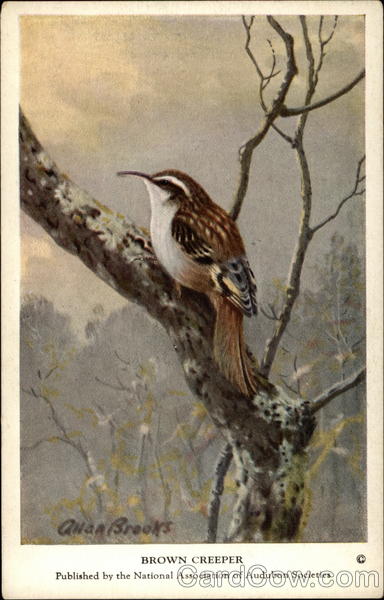Front:
auanBreoks
BROWN CREEPER
Published by the National Association of Audubon Societies
Back:
No. 49 Brown Creeper
Length 51 inches
This curious little climber of tree trunks is
fairly common throughout the United States in
winter. In the minds of bird-lovers he is usually
associated with Downy Woodpeckers, Chickadees
and Nuthatches, for, like them, he enlivens our
winter woods, and also comes about our homes
for the suet that is provided. O
The spiral clamberings of th&Brown Creeper
are indeed interesting to observe. Wholly oblivious
of your presence, he cli11bs pétáistently around
the boles of trees, peering into bark crevices and
crannies for the small insects and larvae that
make up his diet. When be reaches the top of the
tree, or the place where the limbs begin to branch,
he usually drops to the base of the next, and again
begins his spiral ascent. He progresses by little
hitches and jumps, and his movements are accom-
panied by faint and highepitehed “screeps” or
"tseeps,” which are emited with much regularity.
In addition to these notes, the Brown Creeper is
said to possess a song of Indescribable sweetness.
The nest is placed beltin Loose bark on dead
trees or stumps, and is usually not far from the
ground. The eggs are from five to eight, white
and speckled with brown.
Classification: Order Passeres. Family Certhiida.
Scientific name: Certhia familias.
Range: Eastern North America, breeding from north-
ern tier of states northward, and southward in the
Rocky Mountains into Mexico. Winters throughout the
United States.
No. 49 from set of 50 Winter Birds of the Northeastern United
States. Published by the National Association of Audubon So-
cieties, 1974 Broadway, New York City. Price per set, in a box,
$1.00 post paid.



